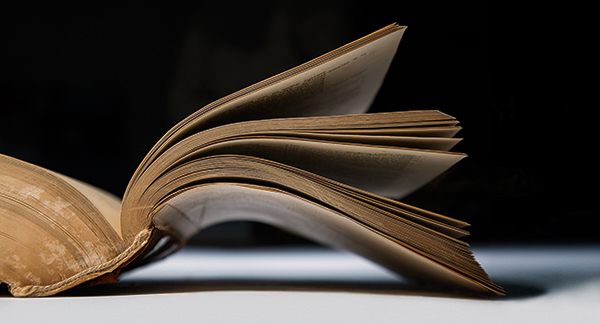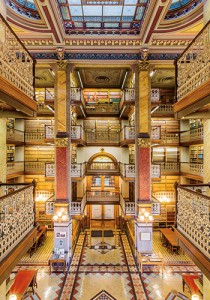Written by Tom Perry
Photos by Ben Easter

Some sights today in the State Law Library of Iowa undoubtedly would bewilder Arthur James Small, the librarian here from 1896 to 1937, such as the female attorneys who frequent the library (women couldn’t even run for the Iowa General Assembly until 1926) and patrons’ personal laptops.
To Small’s relief, perhaps, little else would be different. Most of the interior, except for a few color scheme changes, would be as it was when last he saw it. It continues to occupy a spacious place in the west wing of the Statehouse, commanding more than 5,800 square feet, with an atrium towering to nearly 50 feet. From its tile floors to the stained-glass fixtures overhead, it’s still sumptuous and dazzling, feeling like a cathedral for books.

The State Law Library of Iowa occupies a dazzling space in the Capitol’s west wing. The atrium towers to nearly 50 feet. The exact origins of the tile used in the library are unknown, law librarian Cory Quist says. “Some say England. Some say Italy. We just know they’re from somewhere in Europe,” he says. Some years ago, when the state considered adding electric outlets for laptop users, it was learned that the tiles are essentially irreplaceable, Quist adds.
The spiral staircases and five tiers of balconies, festooned with ornate cast-iron balusters, still create a sense of dignified elegance. Much of the original furniture, including a chair salvaged from a Mississippi River paddleboat, is still in use. Thousands of law books and legal manuscripts, many of which were invaluable resources in a golden age of bibliophiles, remain cataloged among the 105,000 bound volumes.
The library represents an ardent reflection of “Victorian-era living style” more than a reverential homage to a particular architectural style. And it’s been “fortunately left alone,” while those in other states from the late 1800s have been remodeled or lost, law librarian Cory Quist says. The hall opened in 1884, as part of a state Capitol project that involved four architects, cost $2.2 million (more than $70 million in 2014 dollars) and took 15 years to complete, due in part to weather-related problems in 1872 and 1873.
Today, in its 130th year of service, the State Law Library of Iowa might be Des Moines’ greatest tucked-away treasure. It’s regarded by some non-Iowans as one of the most impressive public libraries anywhere. In 2010, a website called Twisted Sifter, based in Toronto, Canada, rated it as the world’s fourth “most incredible” library based on architecture. But, like an heirloom in an attic, this keepsake is out of sight, out of mind for many who live within driving distance.
The library’s low profile hardly surprises Joni Arnett, Statehouse tour guide supervisor. After almost 40 years of making rounds that take her into the library, she still delights in hearing “a lot of audible oohs and aahs” from many of the 100,000 or so annual visitors. Yet she understands why a place of such enduring beauty is relatively obscure as a local attraction.
“You are just not always aware of everything that is out there and available to you even in your own backyard,” Arnett says.
What’s available is far more than just a shrine to books and manuscripts. In the gathering daylight of a new technological age, the state library is at ease with digital realities. Quist and his colleagues, Mandy Easter and Ellen Bridenstine, staff a fully working law library. They answer more than 400 reference questions a year from lawmakers and the legal community and, with the aid of vastly improving Internet resources, from the general public.
Most telltale signs of the 21st century, such as computers, are strategically concealed, Quist says. The ambience here still mimics Downton Abbey. To some who grew up in analog days, the library can feel as if it is one defibrillator jolt away from reviving all the tiny noises being shushed by progress. It is as if the sound of paper pages being flicked by a thumb could be heard here again in a heartbeat. Yet more important than nostalgia is the statement that echoes through this hall every day: Here is a place that speaks volumes, literally, about the emphasis placed over the decades on the acquisition of knowledge and information, Quist says.
Library’s Roots
To drill that point home, Quist traces the roots of the library to the pre-statehood origins of Iowa. He tells the story of how the seeds for the library were planted with about 300 books that arrived in Iowa’s first capital, Burlington, by paddleboat from Cincinnati in 1838, some eight years before Iowa became a state. Theodore Parvin, a 21-year-old lawyer who traveled as private secretary to Iowa’s newly appointed territorial governor, Robert Lucas, purchased the books with some of the $5,000 (about $100,000 in 2014 dollars) appropriated by Congress on June 12, 1838, after it was decided to split off Iowa from the Wisconsin Territory.
The earliest years of the state library were spent in flux and disarray. For years, the librarian was paid a janitor’s wage. The capital was uprooted from Burlington to Iowa City before its 1854 relocation to Des Moines. A decade later, before leaving office in 1864, Gov. Samuel Kirkwood became the first Iowa governor in a decade to plea on behalf of the library in his annual report to the General Assembly. That year, $3,000 (about $72,000 in 2014 dollars) was appropriated for the library. By 1875, as the process of building a new state Capitol was well underway, State Librarian Ada North reported to state lawmakers from very cramped confines that “probably no western state, except California, has a library equal to ours.”
Digital Data
She was referring to the collection of books, of course. All these years later, books have taken on new characteristics with the arrival of the Internet. Any collection can be added to with money and a few keystrokes. When the Iowa Statehouse went online around 1994, “it changed everything,” recalls Quist, who has worked at the library for 18 years. Today, most funds for acquisitions are spent on access to electronically transmitted data rather than hard copies of books, he says.
The aforementioned Small might disapprove of this development. When it came to books, Small was a zealous bibliophile of almost pack-rat proportions, Quist says. Thousands of the volumes on the shelves today were purchased during the years Small was in charge. Fittingly, the library’s most precious books, including a 474-year-old tome on Roman law, can be found in the room that holds the A.J. Small Collection.
Rare Tomes
Additional rare titles include “Blackstone›s Commentaries” (first edition, 1765) and Black’s Law Dictionary (first edition, 1891). The collection also contains pre- and post-Revolutionary War statute books from several colonies and states as well as “The Laws of the Confederate States of America 1861-1865.” What makes these books valuable is that they are “all original and not reprints,” Quist says.
Whether this would be of some solace to Small can’t be known. But for all that is the same and all that is different today inside the State Law Library of Iowa, Small would undoubtedly agree that it continues to live up to a sentiment expressed by North in her 1875 report to lawmakers. Looking forward, she wrote that with a new Capitol on its way, Iowans could “look forward to the time, when, amid more fitting and beautiful surroundings, the Iowa State Library shall expand into noble and perfect proportions and become a sacred repository of the learning and wisdom of the ages.”














